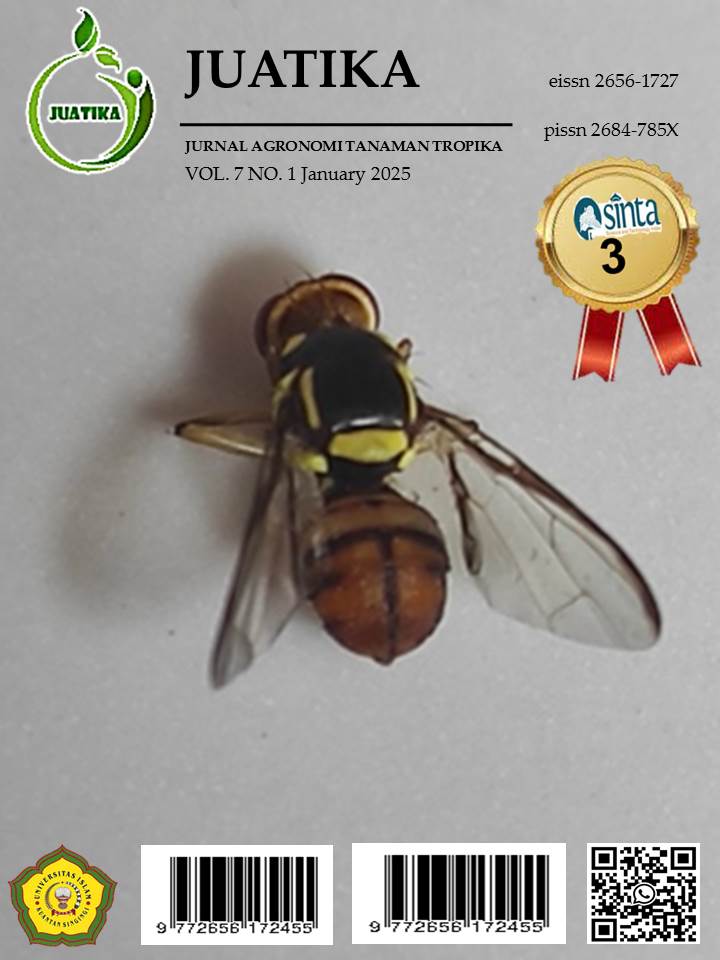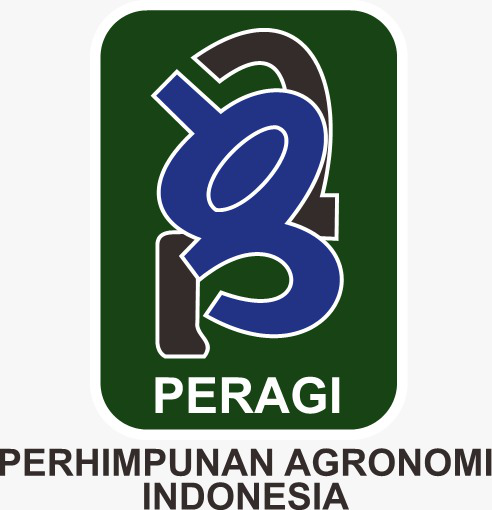Optimizing Eco-enzyme Dosage on Kale (Brassica oleracea) Growth and Production
Abstract
Kale, a member of the cabbage family, is currently witnessing an increase in popularity; however, this heightened interest is not reflected in production levels, primarily due to the excessive application of inorganic fertilizers. To mitigate this challenge, implementing organic fertilizers, such as eco-enzymes, may enhance kale yield. A research study was carried out at the experimental field of the Faculty of Agriculture at Muhammadiyah University of Jakarta from June to October 2022. The study employed a Randomized Block Design (RAK) with six varying doses of eco enzymes, ranging from a control group to 50 mL per plant. Each treatment was replicated four times, with three plants allocated to each experimental unit. The parameters assessed included the number of leaves, leaf length, leaf width, gross weight, consumption weight, and root length. Data analysis, utilizing variance (F test) and the DMRT test at a 5% significance level, indicated that varying doses of eco enzymes had a significant impact on plant height, leaf length, gross weight, and consumption weight while showing no significant effect on the number of leaves, leaf width, and root length of the kale plants.
Downloads
References
Aziz, A. N. (2015). Kandungan amonium dan nitrat tanah pada budidaya putih dengan menggunakan pupuk urin manusia. Bionature, 16(2), 86-90.
Dalmadi. (2010). Syarat Tumbuh Brokoli. Jakarta: Direktorat Jenderal Hortikultura.
Devina, M. (2012). Pengaruh bahan dan dosis kompos cair terhadap pertumbuhan selada (Lactusa sativa L.). Jurnal Agroteknologi Universitas Jambi, 1(1), 16-22.
Faqih, A. d. (2017). Pengaruh kombinasi konsentrasi pupuk organik cair (super farm) dan kultivar terhadap pertumbuhan dan hasil pakcoy (Brassica rapa L.). Jurnal Agroswagati, 5(1), 556-565.
FE, A. (2011). Mineral, vitamin C, and crude protein contents in kale (Brassica oleraceae var. acephala) at different harvesting stages. African Journal of Biotechnology, 10(75), 17170-17174.
Febby, N., & Hakim, K. (2024). Pertumbuhan tanaman bayam horenzo (Spinacia orelacea L.) dengan pemberian nutrisi menggunakan ekoenzim. Journal of Tropical Agriculture Sciences, 1(2), 114-125.
Ginting, N. N. (2021). Effect of eco enzymes dilution on the growth of turi plant (Sesbania grandiflora). Jurnal Peternakan Integratif, 9(1), 29-35.
Handayani, F. S. (2020). Pengaruh komposisi media tanam dan dosis pupuk nitrogen terhadap pertumbuhan dan hasil tanaman kailan (Brassica oleraceae var. alboglabra). Jurnal Agrowiralodra, 3(2), 36-45.
Harjoko, D. D. (2019). The effects of arenga wood-fiber size and nutrition concentration on growth and yield of substrate hydroponic kailan (Brassica alboglabra). IOP Conference Series: Earth and Environmental Science, 250.
Khairunnisa. (2021). Pemberdayaan masyarakat melalui sosialisasi pemanfaatan ekoenzim pada petani ubi kayu di Desa Glugur Rimbun Kecamatan Kutalimbaru Kabupaten Deli Serdang. Surakarta: Fakultas Pertanian UNS.
Laki, A. S., & Wijaya, M. (2021). Pengaruh pupuk organik terhadap pertumbuhan dan hasil tanaman kale (Brassica oleracea var. acephala) sistem vertikultur. Jurnal Ilmiah Respati, 12(2), 133-146.
Moi, R. A. (2015). Pengujian pupuk organik cair eceng gondok (Eichhornia crassipes) terhadap pertumbuhan sawi (Brassica juncea). Jurnal MIPA Unsart Online, 4(1), 15-19.
Najla, L., & Wijaya, M. (2022). Respon pemberian ekoenzim dan pupuk organik cair terhadap pertumbuhan dan produksi bawang merah (Allium ascalonicum L.). Agrium, 25(2), 107-115.
Pramitasari, H. E. (2016). Pengaruh dosis pupuk nitrogen dan tingkat kepadatan tanaman terhadap pertumbuhan dan hasil tanaman kailan (Brassica oleraceae L.). Jurnal Produksi Tanaman, 4(1), 49-56.
Pramushinta, I. A. K., & Yulian, R. (2020). Pemberian POC (pupuk organik cair) air limbah tempe dan limbah buah pepaya (Carica papaya L.) terhadap pertumbuhan dan produktivitas tanaman pakcoy (Brassica rapa L.). Journal of Pharmacy and Science, 5(1), 29-32.
Prasetya, M. (2015). Pengaruh pupuk NPK mutiara dan pupuk kandang sapi terhadap pertumbuhan dan hasil tanaman cabai merah keriting varietas Arimbin (Capsicum annum L.). Jurnal Agrifor, 13(2), 191-198.
Rahayu, M. I. (2021). Acceleration of production natural disinfectants from the combination of eco enzyme domestic organic waste and frangipani flower (Plumeria alba). Sustainable Environment Agricultural Science, 5(1), 15-21.
Ritomga, I. A. (2022). Pengaruh metode aplikasi eco enzyme terhadap pertumbuhan lahan kangkung (Ipomea reptans Poir.). Serambi Biologi, 3(7), 216-222.
Rochyani, N. U. (2020). Analisis hasil konversi eco-enzyme menggunakan nenas (Ananas comosus) dan papaya (Carica papaya L.). Jurnal Redoks, 2(5), 135-140.
Widarawati, R., & Purwanti, B. (2023). Aplikasi ekoenzim terhadap pertumbuhan tanaman bayam merah (Amaranthus tricolor L.) pada sistem hidroponik rakit apung. Prosiding Seminar Nasional Fakultas Pertanian dan Perikanan, 5, 1-7.
Saifuddin, M. A. (2021). Impacts of shading on flower formation, leaf chlorophyll, and growth of Bougainvillea glabra. Asian Journal of Plant Sciences, 9(1), 20-27.
Salsabila, R. W. (2023). Efektivitas pemberian ekoenzim kulit buah sebagai pupuk organik cair terhadap pertumbuhan tanaman sawi pakcoy (Brassica rapa L.). LenteraBio, 12(1), 50-59.
Tando, E. (2019). Upaya efisiensi dan peningkatan ketersediaan nitrogen dalam tanah serta serapan nitrogen pada tanaman padi sawah (Oryza sativa L.). Buana Sains, 2(18), 171.
Tisdale, L. L. (2020). Soil Fertility and Fertilizers. New York: Macmillan Publishing Co.
Wiryono, B. S. (2021). Efektivitas pemanfaatan eco enzyme untuk meningkatkan pertumbuhan tanaman sawi dengan sistem hidroponik DFT. Mataram: Fakultas Pertanian Universitas Muhammadiyah Mataram.
Yulipriyanto, H. (2010). Biologi Tanah dan Strategi Pengelolaannya. Yogyakarta: Graha Ilmu
Copyright (c) 2025 Helfi Gustia, Yukarie Ayu Wulandari, Rosdiana, Dirgahanai Putri

This work is licensed under a Creative Commons Attribution 4.0 International License.
Authors who publish with Jurnal Agronomi Tanaman Tropika (JUATIKA) agree to the following terms:
Authors retain copyright and grant the Jurnal Agronomi Tanaman Tropika (JUATIKA) right of first publication with the work simultaneously licensed under a Creative Commons Attribution License (CC BY 4.0) that allows others to share (copy and redistribute the material in any medium or format) and adapt (remix, transform, and build upon the material for any purpose, even commercially) with an acknowledgment of the work's authorship and initial publication in Jurnal Agronomi Tanaman Tropika (JUATIKA).
Authors are able to enter into separate, additional contractual arrangements for the non-exclusive distribution of the journal's published version of the work (e.g., post it to an institutional repository or publish it in a book), with an acknowledgment of its initial publication in Jurnal Agronomi Tanaman Tropika (JUATIKA). Authors are permitted and encouraged to post their work online (e.g., in institutional repositories or on their website) prior to and during the submission process, as it can lead to productive exchanges, as well as earlier and greater citation of published work.







 More Information
More Information



